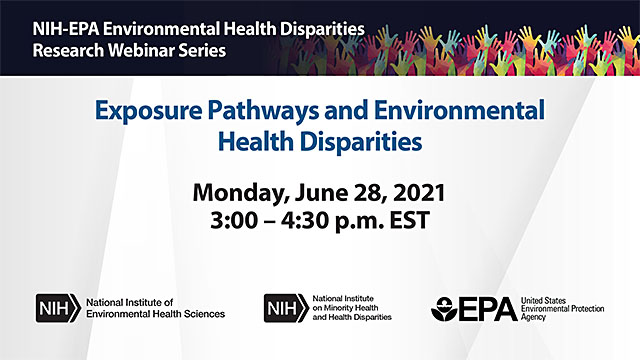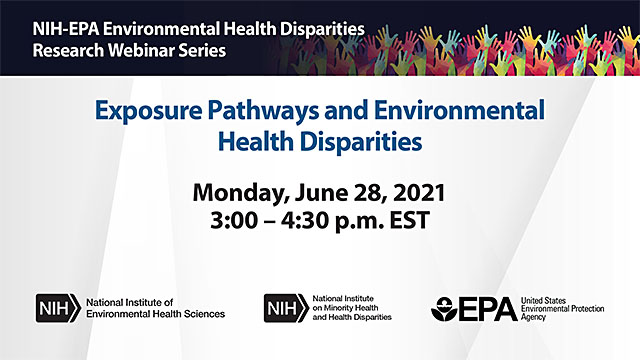Exposure Pathways & Environmental Health Disparities
Moderators: Johnnye Lewis, Professor, University of New Mexico and Rich Callan, Environmental Health Scientist, U.S. Environmental Protection Agency
| Time | Event |
|---|---|
| 3:00-3:05 p.m. |
Introduction of Presenters |
| 3:05-3:25 p.m. |
Black Carbon Content in Airway Macrophages Is Associated With Reduced CD80 Expression and Increased Exacerbations in Former Smokers With COPD |
| 3:25-3:45 p.m. | Investigating the Impact of Microbial Processes on Arsenic Stability in Sediments From Cheyenne River Center Affiliation: Center for Native American Environmental Health Equity Research Presenter: Lucia Rodriguez-Freire, Assistant Professor, New Jersey Institute of Technology |
| 3:45-3:55 p.m. | Q&A for Scientific Presentations |
| 3:55-4:15 p.m. |
Environmental Exposures and Health Disparities: Lessons Learned from the Centers of Excellence on Environmental Health Disparities Research Center for Indigenous Environmental Health Research Center for Native American Environmental Health Equity Research Center for Research on Environmental and Social Stressors in Housing Across the Life Course (CRESSH) Comparing Urban and Rural Effects of Poverty on COPD (CURE COPD) Maternal and Developmental Risks from Environmental and Social Stressors (MADRES) |
| 4:15-4:30 p.m. |
Q&A for Center Directors |
NIH-EPA Environmental Health Disparities Research Webinar Series
Part 01 - Intro, Presentation 1, Presentation 2, and Q & A

Part 02 - Presentation 3, and Discussion/Q & A

Abstracts
Black Carbon Content in Airway Macrophages Is Associated With Reduced CD80 Expression and Increased Exacerbations in Former Smokers With COPD
Investigator: Vickram Tejwani, M.D., JHU Research & Clinical Fellow, Medicine-Pulmonary and Critical Care Medicine
Abstract:
Background Chronic obstructive pulmonary disease (COPD) is characterized by recurrent exacerbations. Macrophages play a critical role in immune response and tissue repair in COPD. Airway macrophages (AM) are exposed to environmental exposures which are retained in the cytoplasmic material. Both biomass and particulate matter have been linked to higher AM black carbon. It is unknown if AM black carbon is associated with COPD morbidity and macrophage phenotype.
Methods: Former smokers with COPD were enrolled and sputum induction was performed to obtain airway macrophages. Macrophages underwent black carbon quantification and flow cytometry phenotyping. Health information was obtained the same day as sputum induction and prospective exacerbations were assessed by monthly telephone calls.
Results: We studied 30 former smokers with COPD that had a mean age of 67 years and mean FEV1% predicted of 60.8%. Higher AM black carbon content was associated with increased total exacerbations and severe exacerbations and reduced CD80 expression.
Conclusions: AM black carbon association with respiratory morbidity is largely unexplored and this is the first study to identify association with prospective exacerbations. Macrophages expressed reduced CD80, a surface marker providing costimulatory signals required for development of antigen-specific immune responses. Our findings suggest that reduced CD80 expression is the pathophysiologic mechanism for the association of AM black carbon content and increased exacerbations. Therefore, beyond solely serving as a marker for increased exposures, AM black carbon content may be predictor of future exacerbations given a macrophage less equipped to respond to an acute infectious exposure.
Investigating the Impact of Microbial Processes on Arsenic Stability in Sediments from Cheyenne River
Investigator: Lucia Rodriguez-Freire1, Cherie De Vore2, Noelani Villa2, Maedeh Soleimanifar1, Jorge Gonzalez-Estrella3, Abdul Mehdi Ali2, Juan Lezama-Pacheco4, Carlyle Ducheneaux5, José M. Cerrato2
1New Jersey Institute of Technology
2University of New Mexico
3Oklahoma State University
4Stanford University
5Department of Environment and Natural Resources, Cheyenne River Sioux Tribe
The contamination of arsenic (As) and other co-occurring metals (i.e., chromium, vanadium and mercury) in surface water and sediment has occurred due to mining legacy conducted across the Western United States near Native American lands. The Cheyenne River Sioux Tribe (CRST) in South Dakota has expressed their concerns for the millions of tons of mine waste released into the Cheyenne River between the 1870’s and 1980’s from the Homestake Mine, the largest and deepest gold mine in North America. Mining demonstrates a particular arena of risk and exposure to rural communities, miners and residents of areas exposed to contamination. Our current analyses have measured high As concentration (2,020 mg kg-1) in the sediments in the Whitewood Creek, which flows into the Belle Forche River draining in the Cheyenne River. Moreover, we have identified elevated As (90– 394 mg kg-1) in the riverbank sediments and floodplain soils in the reservation land, more than a hundred miles downstream from the mine. Hence, we need to investigate the factors impacting metal stability and mobilization from the sediments to the water, and eventually into plants used by the community. Our research objective is to investigate the role of microorganisms in arsenic mobilization from the sediments from Cheyenne River Sioux Tribe. Our hypothesis is that microbially-driven redox transformation will impact the stability of arsenic in the sediments by catalyzing the dissolution of arsenic-bearing mineral phases.
We integrated aqueous chemistry, spectroscopy, and microbiology techniques to identify chemical and microbial processes affecting the release of As, iron (Fe), and manganese (Mn) from sediments contaminated exposed to aerobic and anaerobic conditions. The highest release of As, Fe, and Mn was obtained when transitioning from aerobic to anaerobic conditions in batch experiments reacted with glucose, compared to those reacted with phosphate. Glucose acts an electron donor influencing microbial reductive dissolution caused by anaerobic respiration and should be considered as an important process for metal mobilization in systems transitioning from aerobic to anaerobic conditions. The outcomes of this pilot project will have an invaluable impact on the Cheyenne River Sioux Tribe as it will provide a comprehensive understanding of the microbial processes affecting arsenic speciation and their stability in the sediments from Cheyenne River Sioux Tribe. This information will directly address the overall goal of the Native EH Equity Center to develop models and analytical procedures to understand exposure pathways, climactic/land-use variables, and biogeochemical/minerological factors. In addition, the results from this research will define specific metal-uptake mechanisms by plants, which aligns with Environmental Monitoring and Interpretation Core objective to quantify environmental exposures to metals resulting from traditional and cultural practices.


